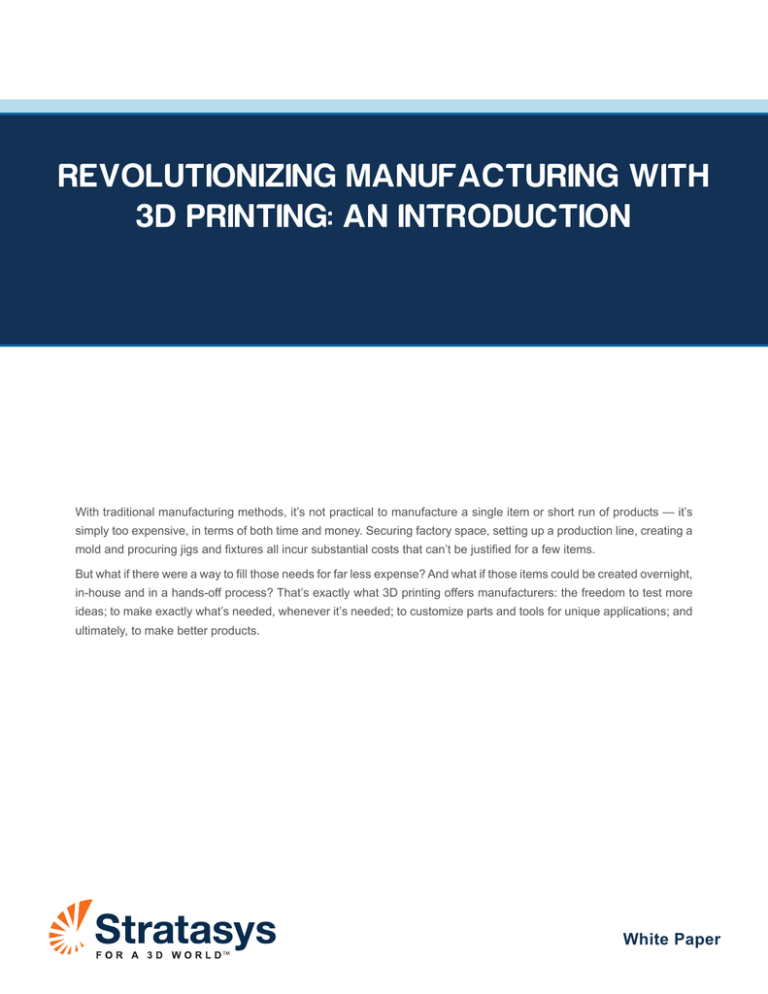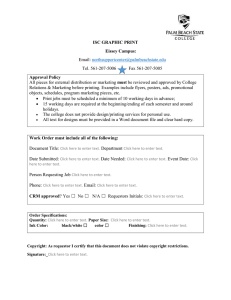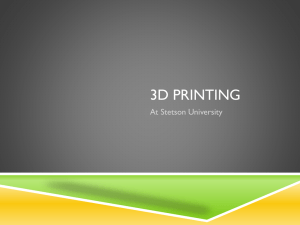
REVOLUTIONIZING MANUFACTURING WITH
3D PRINTING: AN INTRODUCTION
With traditional manufacturing methods, it’s not practical to manufacture a single item or short run of products — it’s
simply too expensive, in terms of both time and money. Securing factory space, setting up a production line, creating a
mold and procuring jigs and fixtures all incur substantial costs that can’t be justified for a few items.
But what if there were a way to fill those needs for far less expense? And what if those items could be created overnight,
in-house and in a hands-off process? That’s exactly what 3D printing offers manufacturers: the freedom to test more
ideas; to make exactly what’s needed, whenever it’s needed; to customize parts and tools for unique applications; and
ultimately, to make better products.
White Paper
and readily accessible, designers make more prototypes to test
their ideas thoroughly.
“It’s important for our prototype parts to look and feel like
production parts,” said Mike Zeigle, manager of Trek’s prototype
development group. “The new Objet500 Connex3™ 3D Printer
allows us to print multiple materials in multiple colors.”
“A good example is, in the morning, we print handle bar grips on
the Connex3, and we put them on the bike. Our test riders take the
bike to the trails across the road for a test ride,” added Zeigle. “By
the end of the afternoon, the engineer either has a good design,
or he can go start all over again, make some modifications to it
and the next day make another part.”
OUTSOURCED OR ON SITE?
Manufacturers with experience outsourcing 3D printed parts
sometimes find it difficult to justify the cost of acquiring
equipment on site. But often, once they have in-house 3D printing
capabilities, they realize a broader set of applications that prove
With an in-house 3D printer, manufacturers can create tools such as assembly
fixtures and jigs overnight and put them into use the next day.
3D printers and 3D production systems can help manufacturers
create detailed prototypes, essential manufacturing tools and
durable end-use parts — without sharing confidential design
information or waiting weeks for items to be shipped.
PROTOTYPES: GETTING IT
RIGHT FROM THE START
more than valuable enough to justify the investment. Fender
Musical Instruments Corporation, known for its iconic guitars, has
decreased its time to market by 40 percent by moving to in-house
3D printing.
The switch from using a service bureau meant that instead of waiting
as long as two weeks for a prototype, Fender designers produced
one overnight. In addition, Fender found that it was ultimately half
as expensive to produce its own prototypes; it typically costs just
$4 to $6 per cubic inch to produce a part on a 3D printer.
With an in-house 3D printer, manufacturers can inexpensively
produce multiple iterations of a design. Today’s 3D printers are
capable of producing realistic, precise multi-material prototypes
that incorporate everything from rubber grips to clear panels. Or,
specialized materials with certifications for biocompatibility or
temperature and chemical resistance, can take prototyping to a
functional level. These accurate models give manufacturers the
opportunity to identify problems and perfect the details of their
designs before moving forward.
Catching design errors before committing to a production run can
yield big savings, but there’s another benefit to using 3D printing at
this early stage: When prototype production is quick, inexpensive
Trek’s Objet500 Connex3 created this durable Digital ABS™ chain guard with
rubber-like components in one print job.
2
But the question of where to have prototypes made doesn’t have
to be an either/or choice. Some customers own one or more 3D
printers and opt to supplement their production by outsourcing
to service bureaus offering production facilities around the globe.
This is a perfect solution for when they need extra capacity or a
larger build size than their own machine can accommodate.
TOOLS: MAKING THE THINGS THAT
MAKE THINGS
Many manufacturing tools can be created with 3D printing more
quickly, and less expensively, than with traditional methods.
Molds, templates, jigs and fixtures — all can be ready for use in
hours, not weeks.
Thogus Products is an injection molder that specializes in lowvolume manufacturing and highly engineered materials. According
to Natalie Williams, quality manager at Thogus, “It is so much
easier for me to model a fixture and print it myself than it is to
design it and work through an outside machine shop.”
A PATH TO SAVINGS — AND SPEED
“Jigs, fixtures, guides and gauges are usually produced in very
low quantities, so they are expensive,” said Terry Wohlers, 3D
printing expert and president of the independent consulting firm
Wohlers Associates. “3D printing is often better at producing low
Tools such as assembly fixtures and jigs are ideal candidates for 3D printing,
which can easily produce small numbers of custom-designed items.
volumes compared to conventional manufacturing, so companies
can reduce time and cost.”
For Thogus, 3D printing is easy and fast. “For one 12-cavity
CMM fixture, the lead time, if outsourced, was 7 to 10 days. I
built it overnight,” said Williams. Manufacturers using FDM®based 3D printers and 3D production systems to create custom
manufacturing tools often experience lead-time reduction of 40 to
90 percent.
3D printing increases return on investment by reducing the cost
of a jig or fixture. Typically, companies realize savings of 70 to 90
percent when compared to outsourced fixtures that are machined
or fabricated. For Thogus’ 12-cavity fixture, the savings were 87
percent. “The machine shop wanted $1,500 for the fixture. I made
it for less than $200 in materials,” said Williams.
With 3D printing’s flexibility, manufacturers can create their own
tools as a permanent solution or as a stopgap measure. For
example, a manufacturer who has to wait weeks for an injection
Thogus Products used 3D printing for part extraction and placement, reducing
direct labor and expenses.
mold to arrive can produce that mold in-house and take advantage
of bridge manufacturing to get to market sooner.
3
At BMW, engineers have discovered that there are even greater
advantages from the design freedom that 3D printing offers.
Engineers Günter Schmid and Ulrich Eidenschink used 3D
printing to make ergonomically designed assembly aids that
perform better than conventionally made tools.
To improve productivity, worker comfort, ease of use and
process repeatability, the plants used 3D printing to enhance the
ergonomics of its hand-held assembly devices. The engineers
created tool configurations to improve handling, reduce weight
and improve balance. According to Schmid, “The tool designs we
create often cannot be matched by machined or molded parts.”
In one example, BMW reduced the weight of a device by 72
percent with a sparse-fill build technique. Replacing the solid core
with internal ribs cut 1.3 kg (2.9 lbs) from the device. “This may
not seem like much, but when a worker uses the tool hundreds of
times in a shift, it makes a big difference,” said Schmid.
THE RIGHT TOOL FOR THE JOB
“A 3D printed tool can last as long as the metal version, but you
do have to understand what the best use is for the technology,”
said Ryan Sybrant, business development manager at Stratasys.
“We’re not saying 3D printing is going to cannibalize CNC or
injection molding, but for applications when you can use it to
Creating injection molds (top) and metal forming tools (bottom) on an in-house
3D printer is typically faster and less expensive than outsourcing them to a
machine shop.
optimize production and be more economical, it’s absolutely the
right choice.”
Modern materials yield sturdy 3D printed tools that can resist
REPLACING HEAVY METAL
petroleum, solvents and temperatures of up to 390°F. “There
Traditionally, tooling has been crafted from metal using
are tools that have been on factory floors for years,” Sybrant
techniques such as milling. It’s an expensive, time-consuming
affirmed. “But if a tool does wear out or break, a replacement can
process that often must be outsourced to a machine shop. By
be created overnight.”
opting for 3D printed plastic tooling instead, manufacturers
That speed also gives manufacturers a new workflow option:
can save money, put the tool into use on the factory floor
digital warehousing. Instead of storing an infrequently used
sooner, and even improve its design for greater efficiency and
metal tool, workers can print a plastic version, discard it when the
better ergonomics.
need has passed, then print another from the stored digital file.
Because 3D printing can create designs that cannot be
“Inventory space is a luxury, and it costs time and money to track
manufactured by milling, tools can incorporate enclosed hollow
tools all the time,” said Sybrant.
areas that reduce material use and weight. Plastic tools are also
lighter than their metal counterparts by nature, a benefit that can
reduce worker fatigue.
4
PARTS: END-USE QUALITY
In addition to prototypes and tooling, modern 3D printing
technology can produce durable, stable end-use parts —
bypassing the production line altogether. The Production
Series from Stratasys uses a range of materials, including
production-grade thermoplastics, to create parts with predictable
mechanical, chemical and thermal properties.
“Low-volume production is a market segment that traditionally
hasn’t been covered well,” Sybrant noted. “Most injection molding
houses, for example, won’t take an order under a set number
of components, or they charge a high fee to make it worth their
while. It often makes more sense to complete the job in-house
instead.”
Whale, based in Northern Ireland, manufactures and exports
pumps and drainage devices for mobile applications. Injection
molding is a core competency for Whale. In the past, Whale
outsourced its injection molding prototyping to service bureaus
and often ordered the parts from as far away as China.
Whale began investigating the possibility of using 3D printing for
injection molds. Despite initial skepticism, they found Digital ABS
had the ideal properties for low-volume part production — high
temperature resistance and toughness.
Prior to acquiring 3D printers, Whale’s metal injection molding
tools took four to five weeks to produce and cost tens of thousands
of pounds sterling. These tools are now designed during the day,
3D printed overnight and tested the next morning with a range of
end-product materials.
Patrick Hurst, the managing director at Whale, explained, “We
have already seen the technology take months off of our product
development process and that in turn minimizes risk. In fact,
I estimate that we’ve shortened our R&D process by up to 35
percent with 3D printing solutions. Add that on top of the 20
percent we’re already saving in terms of our design work — well
for me, it’s fantastic.”
These functional prototype diaphragms were made with Santoprene using a 3D printed
injection mold (foreground). The CNC tool previously used to create the same part is
shown in the background.
usually in the tens or hundreds, but the quantity can vary greatly,
depending on the value, size and complexity of the parts.”
Kelly Manufacturing Company (KMC), the world’s largest
manufacturer of general aviation instruments, makes the R.C.
Allen line of aircraft instrumentation. It used 3D printing to modify
a toroid housing in a turn-and-bank indicator. Previously, these
parts were made from urethane molded in soft, rubber tooling.
This was the process of choice for low-volume production,
because it’s much cheaper and faster than a composite layup.
But 3D printing has replaced rubber molding since it further
reduces cost and time.
The toroid housing, cast in a rubber mold, would have taken three
to four weeks for a 500-piece order. Now KMC produces 500
toroid housings in one overnight run of its FDM system. Justin
Kelley, KMC president, said, “From order to delivery, it takes only
three days to have certified production parts.”
As Wohlers explained, the items in a single run “can be similar
yet different, as in the case of dental copings (for crowns and
bridges), plastic dental aligners (for straightening teeth), and in-
THE MAGIC NUMBER
the-ear hearing aids. With these examples, thousands of parts
What size of production run is appropriate for 3D printing? “That
depends on the size of the items,” explained Sybrant, who
has seen production runs for 2,500 pieces. Wohlers said, “It is
are produced, yet each one is unique in shape and size.”
Wohlers Associates said overall mass customization growth
accelerated to 34.9 percent in 2013. Analyst firm Canalys pegs
5
“Advances in technology are yielding faster print times and
enabling objects to be printed in greater combinations of materials,
colors and finishes,” said Canalys senior analyst Tim Shepherd
in a press release. “Crucially, prices are also falling, making the
technology an increasingly feasible option for a broad variety of
enterprise and consumer uses, restricted only by computer-aided
design competencies and printer availability — both of which are
set to improve significantly.”
The pattern of adoption and implementation are clear: 3D printing
accelerates change in manufacturing, and companies should
embrace and learn to leverage this technology. Regardless of the
size of their focus, manufacturers need to improve their product
quality and their speed to market. The prototyping, tool creation
and short-run production capabilities of 3D printing technology
500 toroid housings are produced overnight with a Fortus 3D Production System.
can help them achieve these goals.
the market will expand by 45.7 percent annually from now till
2018, and consumer products will help drive gains.
VERSATILITY: BENEFITS FOR
MANUFACTURERS OF ALL SIZES
Large organizations can benefit from 3D printing — but so can
smaller companies. This technology allows them to compete with
much larger competitors because they can be more agile and
possibly quicker to market. 3D printing can also lower their cost
to market and improve the quality of designs.
Stratasys | www.stratasys.com | info@stratasys.com
7665 Commerce Way
Eden Prairie, MN 55344
+1 888 480 3548 (US Toll Free)
+1 952 937 3000 (Intl)
+1 952 937 0070 (Fax)
2 Holtzman St.
Science Park, PO Box 2496
Rehovot 76124, Israel
+972 74 745-4000
+972 74 745-5000 (Fax)
ISO 9001:2008 Certified
©2014 Stratasys Ltd. All rights reserved. Stratasys, Stratasys logo and PolyJet are trademarks or registered trademarks of Stratasys Ltd. and/or its
subsidiaries or affiliates and may be registered in certain jurisdictions. Fused Deposition Modeling, Objet, Objet500 Connex3 and Digital ABS are
trademarks of Stratasys Inc. Product specifications subject to change without notice. Printed in 2014 and in the USA.
SSYS-WP-How3DPrintingIsRevolutionizingManufacturing-10-14.
For more information about Stratasys systems, materials and applications, call 888.480.3548 or visit www.stratasys.com



